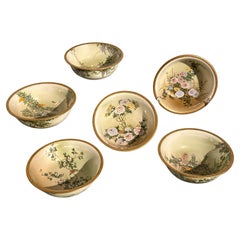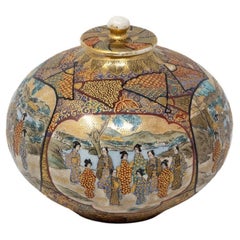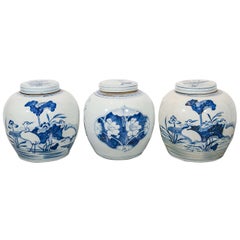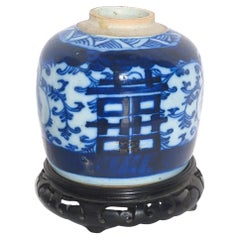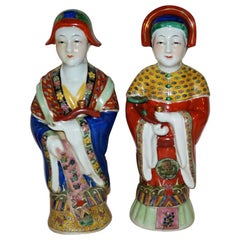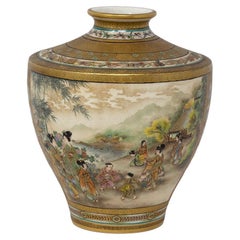Early 1900s Ceramics
1
44
to
4
32
7
44
44
44
1
798
1,184
1,500
1,191
545
361
141
44
7
32
20
15
50
27
19
14
6
42
20
5
5
5
41
39
25
14
1
9
2
2
1
1
Period: Early 1900s
Six Kinkozan Bowls with Birds and Flowers of the Months, Meiji Period, Japan
By Kinkozan
Located in Austin, TX
A very fine partial set of six Japanese Satsuma bowls decorated with flowers and birds of the months, signed Kinkozan, Meiji Period, circa 1900, Japan.
The set of six exquisitely pa...
Category
Japanese Meiji Antique Early 1900s Ceramics
Materials
Ceramic, Stoneware
Japanese Meiji Period Satsuma Koro
By Kinkozan
Located in Newark, England
Bulbous Form
From our Japanese collection, we are delighted to offer this Japanese Meiji Period Satsuma Koro. The Japanese Satsuma Koro of rounded form neatly potted with a small to...
Category
Japanese Meiji Antique Early 1900s Ceramics
Materials
Ceramic, Earthenware, Pottery
Antique Chinese Porcelain Jars
Located in New York, NY
Antique Chinese covered porcelain jars with various images including swans on two jars and babies on a third jar. Priced individually. From Shanxi province, circa 1900.
Dimensions: ...
Category
Chinese Antique Early 1900s Ceramics
Materials
Porcelain
Antique Chinese Blue&White Porcelain Double Happiness Ginger Jar Vase c.1900
Located in Richmond, CA
Antique Chinese Qing dynasty blue and white ginger jar, hand painted with two double happiness characters on scrolling foliage background with large peony blossoms in cobalt blue.
...
Category
Chinese Chinese Export Antique Early 1900s Ceramics
Materials
Porcelain
Pair Antique Emperor & Empress Figure Figurine Statue Hand Painted Qing Dynasty
Located in Wayne, NJ
Sold as a Pair. Antique emperor and empress figure figurine statue hand \painted 12.5" Qing Dynasty. This is an old pair of Asian Figurines. They are heavy, so believe they must be s...
Category
Chinese Export Antique Early 1900s Ceramics
Materials
Ceramic
Japanese Meiji Period Satsuma Vase Painted by Ryozan for the Yasuda Company
Located in Newark, England
The vase of slightly bulbous form potted with a tapered body reaching a slightly pinched neck and rolled top rim is beautifully decorated with two large scenes. The first scene features a mountainous region with a river flowing through the centre with beautiful wash colours of green. A Bamboo plant can be seen hanging over the left of the scene with two Geishas walking amongst the flowers with children running around them. Further Geishas can be seen to the far right of the vase in front of a traditional Japanese building. The second scene an upstream version of the first with spectacular pink cherry blossom amongst a central river breaking the land in two with further figures with children. The scenes bordered by a strip gilt border featuring alternating images two depicting a Minogame. The shoulder of the vase is beautifully finished with complex rings of geometric scrolling borders with shades of teal, butterflies and one hundred treasures style decoration above gilt cartouches of the imperial style Kiku (chrysanthemum). The vase is signed to the base Dai Nippon, Kyoto Tojiki, Goshi Kaisha, Okamoto Ryozan 京都陶, 磁器合, 資会社,岡曰本亮山 with the Yasuda Company Mark (Yasuda Kyoto Tojiki Goshikaisha) which translates as the Yoshida Kyoto Ceramic Joint Stock Company and dates to the Meiji Period (1868-1912) circa 1900.
Yasuda Company was founded in 1896 by Gensei and Yoshizaburo Yasida two brothers from Kyoto. The companies full name is Yasuda Kyoto Tojiki Goshikaisha which translates to Yoshida Kyoto Ceramic Joint Stock Company. They were a manufacturer and dealership based in Kyoto and active during the second half of the Japanese Meiji-era specialising in decorative works including Cloisonne and Ceramics, today they are best-known for their Satsuma pottery wares. The company gained a good reputation and great respect for their high quality works which were executed by some of the best artists of their time. As well as Okamoto Ryozan, they worked with celebrated artists such as Sozan, Kizan, Hozan and Seikozan.
Ryozan was born Nakamura Tatsunosuke and was trained by the legendary 10th generation potter Nishimura Zengoro who himself, used the artist’s name “Ryozan”. After Nishimura’s death in 1851, Nakamura Tatsunosuke adopted the name “Okatomo Ryozan” in order to pay tribute to and honour his master. Ryozan went on to become the Head Artist at the Yasuda Company of Kyoto where he confirmed his reputation as one of the great Satsuma artists of the generation.
Minogame 蓑亀 are long-lived turtles with long strands of algae growing from their shells. The algae drapes down from their shells and resembles a farmer’s straw raincoat (mino) from which they get their name. They are considered very auspicious creatures throughout East Asia. The long algae on their backs is reminiscent of the long beards of sages and wise men. Because of this and their long life span, they are a symbol of long life and prosperity and appear frequently in paintings, sculpture in Japanese culture. The minogame is a symbol of longevity and happiness and has an important role in the well-known legend of Urashima Taro...
Category
Japanese Meiji Antique Early 1900s Ceramics
Materials
Ceramic, Earthenware, Pottery
Ito Tozan I "Basket and Frog" Ceramic Vessel, Meiji Period, circa 1900, Japan
By Ito Tozan I
Located in Austin, TX
A large and whimsical glazed stoneware "Basket and Frog" vessel or basin by Ito Tozan I (1846 - 1920), Meiji Period, circa 1900, Japan. Impressed maker's mark to the underside readin...
Category
Japanese Taisho Antique Early 1900s Ceramics
Materials
Ceramic, Stoneware
Kutani porcelain Green Pheasant, Japan, Meiji Period.
Located in Gargrave, North Yorkshire
Kutani porcelain okimono of a Japanese Green Pheasant, Japan, Meiji Period. The pheasant modelled, perched upon a large gnarled branch.
Decorated in typically vibrant enamels, and he...
Category
Japanese Meiji Antique Early 1900s Ceramics
Materials
Porcelain
Qing Dynasty Hand-Painted Glazed Pickling Jar, c. 1900
Located in Jimbaran, Bali
This Pickling Jar was once used to pickle eggs and features a wonderful array of hand-painted motifs which include birds, foliage and other subtle symbols and patterning. The hand-pa...
Category
Chinese Qing Antique Early 1900s Ceramics
Materials
Ceramic, Paint
Antique circa 1900 Chinese Very Large Earthenware Dragon Planter Plant Egg Pot
By Satsuma
Located in Autonomous City Buenos Aires, CABA
Antique Chinese glazed ceramic egg cup. This brown glazed stoneware urn displays vibrant turquoise tones within. Large egg planter currently being used as ...
Category
Chinese Chinese Export Antique Early 1900s Ceramics
Materials
Earthenware
Large Japanese Imari Gilt Charger, the Six Immortal Poets, Meiji Period, Japan
Located in Austin, TX
A bold and unusual large 18.5" diameter Japanese gilt ground Imari porcelain charger featuring the Rokkasen, the Six Immortal Poets, Meiji Period, circa 1900, Japan.
The impressive charger features a striking image of the Six Immortal Poets, known as the Rakkasen, seated in fenced pavilion within a lush garden setting and surrounded by numerous books and scrolls. Gnarled pine trees and and branches laden with plum blossoms tower overhead, while chrysanthemum and massive peonies bloom among rocky outcrops.
The scene is unexpectedly and masterfully executed as if on a byobu, a traditional Japanese six panel folding screen. The screen is opened in a dramatic manner, slightly akimbo, almost jumping off the dish, reminiscent of the "screens within screens" genre that developed during the Edo Period. Despite the folds and changes in perspective, the painting remains harmonious and lyrical, with the fully gilt ground adding a sense of warmth and sumptuousness.
The screen is bordered with a geometric bands in the shippo pattern. The shippo pattern features interlocking circles, and symbolizes the Seven Treasures. The shippo pattern on a larger scale serves at the background fo the rest of the charger.
The backside of the charger decorated with two bands with underglaze blue designs. The reserve decorated with scattered stylized blossoms in iron red and gilt.
The Rakkasen, known in English as the Six Immortal Poets, are a group of 9th century Heian Period waka poets whose works were included and praised by name in an anthology of poetry collected by the courtier, poet, and writer, Ki no Tsurayuki. Waka poems are a strict five line...
Category
Japanese Meiji Antique Early 1900s Ceramics
Materials
Porcelain
Rare Japanese Porcelain Painted Footed Dish Makuzu Kozan
By Makuzu Kozan
Located in Atlanta, GA
A rare footed dish in the form of an open scroll painting with literati landscape from the studio of Japanese Potter Makuzu Kozan. Also known as Miyagawa Kozan (1842–1916), Makuzu wa...
Category
Japanese Meiji Antique Early 1900s Ceramics
Materials
Porcelain
Red Lacquer Grain Container
Located in Greenwich, CT
Antique red lacquer wood container was used to store rice or grains. The red lacquer container with two side short handles round shape, construct...
Category
Chinese Antique Early 1900s Ceramics
Materials
Wood
Chinese Porcelain Powder Blue Gilt Dragon Charger, Late Qing Dynasty, China
Located in Austin, TX
A magnificent Chinese powder blue glazed porcelain charger with painted gilt decoration, late Qing Dynasty, circa 1900, China.
The large and impressive Chinese porcelain charger gla...
Category
Chinese Qing Antique Early 1900s Ceramics
Materials
Porcelain
Japanese Meiji Period Satsuma Bowl Kinkozan
By Kinkozan
Located in Newark, England
From our Japanese collection, we are delighted to offer this Japanese Meiji period Satsuma Bowl by Kinkozan. The earthenware bowl with pinched rim extensively decorated on both the exterior and interior. The bowl with a cobalt blue base glaze decorated to the borders with gilt shippo-tsunagi (linked-cash) with scattered medallion roundells. Around the exterior two elongated scenes are featured, one with boys playing games in a courtyard with the other featuring seated scholars in full dress both with raised enamel decoration. The interior features a central scene with Samurai warriors in training fully armoured with swords in a courtyard with landscapes scenes to the background. The central scene bordered by further stylised shippo-tsunagi type decoration with a greek key rim border. The bowl signed to the base Kinkozan dating to the Meiji Period (1868-1912) circa 1900.
Shippo-Tsunagi (linked-cash) or seven treasures, is a traditional Japanese geometric pattern that combines four ellipses in a circle. These ellipses repeat outward to then create more circles, symbolising eternal peace and happiness.
Kinkozan the Kinkozan family have been associated with pottery dating back to 1645. They went on to become the largest producer of Satsuma ware by one individual company, from the end of the 19th century until 1927 after which the factory closed. By the 1850s Kobayashi Sobei (1824-84), Kinkozan Sobei...
Category
Japanese Meiji Antique Early 1900s Ceramics
Materials
Ceramic, Earthenware, Pottery, Faux Leather
Japanese Satsuma Tripod Censer, Koro, Meiji period, Early 20th Century, Japan
Located in Austin, TX
A small and finely decorated Japanese Satsuma tripod incense burner (koro), signed Kyozan, Meiji period, circa 1900, Japan.
The censer, koro, with a compressed body supported by t...
Category
Japanese Meiji Antique Early 1900s Ceramics
Materials
Stoneware
Antique Japanese Meiji Era Porcelain Satsuma Figural Kutani Vase Fu Dogs Geisha
Located in Dayton, OH
"Late Meiji era Kutani vase, circa 1903. A beautiful porcelain blue ground centered by an intricate Geisha flanked by gold figural Foo Dog handles. Features a floral and foliat motif throughout. Signed along the base.
Kutani ware, Japanese porcelain made in Kaga province (now in Ishikawa prefecture). The name “Old Kutani” refers to porcelain decorated with heavily applied overglaze enamels and produced in the Kaga mountain village of Kutani. The powerful Maeda family had established a kiln there by 1656. The clay bodies used were gray and coarse-grained. On most pieces—dishes and bowls were especially common—a white or blue-white matte glaze was decorated in dark, restrained colours, initially greens, yellows, and some reds, and later purples and dark blues. Some items had cobalt blue decoration under a white glaze. The most noted Old Kutani pieces are “Green Kutani,” in which most of the surface is covered in a green or blue-green glaze to which one or two colours have been added (or the glaze is applied evenly over a design executed in black). The bold designs of Kutani ware drew freely from Chinese ceramics, paintings, and textiles. They are renowned for their rich pictorial ornament executed in lively, intense lines.
Owing to local financial problems and difficulties in obtaining the necessary pigments, the Kutani kiln was abandoned some time in the Genroku period (1688–1704). Ceramics production in Kaga enjoyed a renaissance early in the 19th century, however, including the establishment of another kiln at Kutani in the 1820s. In addition to a revival of the styles of Old Kutani ware, there arose a style using gold on a coral-red ground, which was perfected during another spate of activity that began in the 1860s. Technical advances were made and Western-style pigments were adopted, and by the 1890s modern Kutani...
Category
Meiji Antique Early 1900s Ceramics
Materials
Porcelain
Large Important Japanese Meiji Satsuma Covered Urn with Foo Dog
Located in Vero Beach, FL
Large Important Japanese Meiji Satsuma Covered Urn with Foo Dog.
Large impressive Japanese Meiji period (1868-1912) Satsuma porcelain covered urn...
Category
Japanese Japonisme Antique Early 1900s Ceramics
Materials
Porcelain
Vase with Delicate Hand Painted Floral Spray on Neutral Ground-Japan, early 20th
Located in West Palm Beach, FL
Japanese porcelain vase delicately hand painted on an craquelure oatmeal colored ground. The brightly colored design is of prunus blossoms, chrysanthemums and several roosters all ou...
Category
Japanese Japonisme Antique Early 1900s Ceramics
Materials
Enamel
Large Chinese Late Qing Blue and White Porcelain Vase with Lid
Located in New York, NY
This late Qing, Guangxu-period "windswept" guan jar, copying an earlier Ming style, is ornamented with landscapes (on both the body of the jar and the lid), as well as floral and geo...
Category
Chinese Qing Antique Early 1900s Ceramics
Materials
Porcelain
Antique 19th Century Ottoman Islamic Kutahya Pottery Rosewater Dropper, Turkey
Located in Portland, OR
A good antique Islamic Ottoman Kutahya pottery rosewater dropper, Turkey, circa 1900.
The rosewater dropper of globular form with a tall tapering neck...
Category
Turkish Islamic Antique Early 1900s Ceramics
Materials
Pottery
Japanese Miniature Satsuma Vase Yabu Meizan Meiji
By Yabu Meizan
Located in Atlanta, GA
A small Satsuma vase from the studio of Yabu Meizan (birth name Yabu Masashichi; 1853-1934), who is one of the most celebrated and collectible Satsu...
Category
Japanese Meiji Antique Early 1900s Ceramics
Materials
Ceramic
Small Satsuma Earthenware Bowl
Located in Lymington, Hampshire
A small Satsuma earthenware bowl, painted in overglaze enamels and gilt with three fans. Japanese, circa 1900.
Measures: Height 2 inches Diamete...
Category
Japanese Antique Early 1900s Ceramics
Materials
Ceramic
Small Satsuma Earthenware Tea Bowl
Located in Lymington, Hampshire
A small Satsuma earthenware tea bowl, the speckled greyish body decorated with four panels of alternating bijinand flowers, painted in overglaze en...
Category
Japanese Antique Early 1900s Ceramics
Materials
Ceramic
Japanese Ceramic Centerpiece Bowl Makuzu Kozan Meiji Period
By Makuzu Kozan
Located in Atlanta, GA
A beautiful ceramic vessel in the form of Bo, the so-called monk's alms bowl from the studio of Japanese Potter Makuzu Kozan, also known as Miyagawa Kozan (1842–1916), one of the most established and collected ceramist from Meiji Period. Born as Miyagawa Toranosuke, Kozan established his pottery studio in Yokohama circa 1870s and later became one of the appointed artists to the Japanese Imperial household. His work was exhibited in many international fairs that the Meiji government participated at the turn of the century and won many grand prizes.
Of a relatively large size, this piece was made as a decorative center piece for display. It was brilliantly decorated with underglaze paint of a green-on-green bamboo motif, using the novel technique developed by Kozan called Fuki-e (the blow painting). As a result, the bamboos appear took on a three-dimensional quality as if appearing in a mist. Known as one of the most creative ceramists, circa 1887, Kozan started experimenting with new chemical colors from the West in the format of his porcelain glaze. New colors allowed him to create underglaze design that appeared bright, smooth and glossy. To create design that is realistic and dimensional, more common in the western paintings, he was inspired by the native Japanese ink painting technique developed around 1900 by Yokoyama Taikan...
Category
Japanese Japonisme Antique Early 1900s Ceramics
Materials
Ceramic
Antique Chinese Foo Dog Candle Holder
Located in Dallas, TX
An antique Chinese Foo Dog with silver inlaid wood stand. Circa 1900 very fine detail.
Category
Chinese Antique Early 1900s Ceramics
Materials
Ceramic, Wood
Pair Chinese Dragon Fish Glazed Porcelain Vase, Qing Dynasty, 19th-20th Century
Located in Austin, TX
A fantastic pair of Chinese molded and glazed biscuit porcelain vases with leaping dragon fish or makara, late Qing dynasty, circa 1900.
The vases of balu...
Category
Chinese Qing Antique Early 1900s Ceramics
Materials
Porcelain
Japanese Glazed Ceramic and Silver Koro Incense Burner Makuzu Kozan
By Makuzu Kozan
Located in Atlanta, GA
A tri-pod ceramic incense burner (koro) by Japanese Imperial potter Makuzu Kozan (1842-1916) circa late Meiji to the start of Taisho period (1890-1910s). A fine example of the artist's work belonging to the late part of his underglaze paint phase (started around 1887 until his death), the surface of the koro was painted in beautiful shades of blue to depict a continuous landscape not unlike a traditional ink and watercolor hand scroll. The rise and fall mountains recede and fade into the horizon and are dotted with groves of pines. The sky is painted with a beautiful subtle shade of pink, suggesting a time of sunrise or sunset. The koro is fitted with an ensuite reticulated sterling silver hoya (incense cover), pierced with swirling cloud and marked with "pure silver' in Kanji. The base is signed in underglaze blue "Makuzu Kozan Sei" within a double ring. The piece is beautifully potted in form and the decoration was done with expertise using the novel technique developed by Kozan called Fuki-e (the blow painting), in order to achieve the striking landscape known as "Mountain and Water" with sense of dimensions and gradient, the poetic effects normally conveyed only by sumi ink staining on paper. The piece comes with an unsigned tomobako (wood storage box) of a recent age.
Also known as Miyagawa Kozan (1842–1916), Makuzu Kozan was one of the most established and collected ceramist from Meiji Period. Born as Miyagawa Toranosuke, Kozan established his pottery studio in Yokohama around 1870s and later became one of the appointed artists to the Japanese Imperial household. His work was exhibited in many international fairs that the Meiji government participated at the turn of the century and won many grand prizes. Being one of the most creative ceramists, Kozan started experimenting with new chemical colors from the West in the format of his porcelain glaze around 1880s. New colors allowed him to create underglaze designs that appeared bright, smooth and glossy. He even invented his own receipt of cobalt blue to achieve a much brighter yet softer shade, as evident on this vase. To create landscape that is realistic and dimensional, more common in the western paintings, he was inspired by the native Japanese ink painting technique developed around 1900 by Yokoyama...
Category
Japanese Japonisme Antique Early 1900s Ceramics
Materials
Silver
Chinese Export Kendi, Swatow Ware, Porcelain with Polychrome Enamels, circa 1900
Located in Austin, TX
A delightful Swatow ware Chinese export shipwreck porcelain kendi featuring a writing dragon and an apocryphal Tongzhi mark, late 19th or early 20th centur...
Category
Chinese Qing Antique Early 1900s Ceramics
Materials
Porcelain
Middle Eastern Ceramic Mosque Lamp
Located in New York, NY
Very fine quality Middle Eastern blue and white ceramic Mosque lamp with original hardware chains.
Category
Asian Antique Early 1900s Ceramics
Materials
Pottery
Japanese Porcelain Glazed Vase with Dragon Design Mazuku Kozan
By Makuzu Kozan
Located in Atlanta, GA
A porcelain vase with dragon design by Japanese imperial potter Makuzu Kozan (1842-1916), circa 1900s. The vase is made in what is considered early phase of his underglaze period during late Meiji era. In a classic baluster form, the surface of the vase was decorated with a slithering dragon in underglaze iron red circulating the exterior among pink clouds. The animated rendering of the dragon is fine and detailed, with five claws, scales, long tails and highlighted eyes. The pink cloud is misty and called Morotai or the hazy style, created with a unique technique developed in Kozan's studio called fuki-e by blowing the pigment powders onto the surface. Kozan Studio experimented with newly available colors from the west starting in the 1880s, which resulted in the expansion of the palette and style that bridged the east and west aesthetic tradition. Marked in underglaze blue on the base.
Known also as Miyagawa Kozan...
Category
Japanese Japonisme Antique Early 1900s Ceramics
Materials
Porcelain
Chinese Export Porcelain Rose Medallion Vase, Canton, circa 1900
Located in Banner Elk, NC
Chinese export porcelain rose medallion vase, 23in, Canton, circa 1900.
Category
Chinese Chinese Export Antique Early 1900s Ceramics
Materials
Porcelain
Chinese Qing Cobalt Blue and White Porcelain Vase with Dragon Motif
Located in New York, NY
Chinese Qing dynasty baluster shape porcelain vase with rich cobalt blue glaze featuring a white dragon in high relief circling the vase. With stylized handles and a tulip opening. T...
Category
Chinese Qing Antique Early 1900s Ceramics
Materials
Porcelain
Pair of Chinese Amphoras -miniatures-
Located in Buenos Aires, Argentina
Pair of Chinese amphoras -miniatures-
ceramic with mount -ring- in European silver
Origin China, circa 1900
perfect condition
warrior scenes.
Category
Chinese Chinoiserie Antique Early 1900s Ceramics
Materials
Silver
Rare Japanese Ceramic Glazed Bowl Makuzu Kozan Meiji Period
By Makuzu Kozan
Located in Atlanta, GA
On offer is a rare ceramic bowl with overglazed design by the famed Japanese ceramic artist Makuzu Kozan (1842-1916), circa 1906-1916. The bowl is rather unusual from the potter's repertoire with its unique glaze colors and decoration, and it likely belonged to a small series that Kozan made in and after 1906. A bowl of similar glaze and nearly identical dragon motif was recorded as a diplomatic present to the British royalty Arthur Connaught (1883-1932) when he represented King Gorge V in Japan in 1906. Other pieces, such as this bowl, were likely made with similar materials and designs afterwards.
Essentially round in form, the bowl has a generous volume with six harmonious lobes. The bottom of the interior showcases a coiled dragon in red, green and gold slithering on a cobalt blue background. The roundel shares an echoing lobed perimeter, which is further outlined by red and turquois bands and rising sun design. The exterior of the bowl features six stylized Japanese camellias...
Category
Japanese Japonisme Antique Early 1900s Ceramics
Materials
Ceramic
Pair of Dore Bronze Mounted Chinese Famille Rose Porcelain Vases
Located in New York, NY
A fabulous and quite beautiful pair of Louis XVI style dore bronze mounted Chinese Famille Rose porcelain, sgraffito ground covered vases or por pourries. Each is exceptionally hand ...
Category
Chinese Louis XVI Antique Early 1900s Ceramics
Materials
Bronze
Satsuma Earthenware Covered Box, by Kinkozan
By Satsuma
Located in West Palm Beach, FL
A Satsuma Earthenware covered box,
by Kinkozan,
Japanese, Meiji period (1868-1912)
decorated in polychrome enamels and gilt over a clear, crackled glaze, delicately painted with s...
Category
Antique Early 1900s Ceramics
Materials
Earthenware
Pair of Japanese Late Meiji Period Fukagawa Porcelain Vases, circa 1900
Located in Takarazuka, JP
Superb pair of Japanese large Meiji period Fukagawa signed porcelain vases (circa 1900). Intricately hand-painted in cobalt blue underglaze with polychrome and gold overglaze on a st...
Category
Japanese Meiji Antique Early 1900s Ceramics
Materials
Gold
Fantastic Japanese Kutani Charger Figures and Scenes of Daily Life
Located in Amsterdam, Noord Holland
Large and very detailed piece.
Condition
Overall condition perfect in wooden box. Size: 315 mm
Period
Meji Period: circa 1900
Category
Japanese Meiji Antique Early 1900s Ceramics
Materials
Porcelain
Japanese Porcelain Vase Makuzu Kozan Meiji Period
By Makuzu Kozan
Located in Atlanta, GA
A striking blue and white vase from the studio of Japanese Potter Makuzu Kozan, also known as Miyagawa Kozan (1842–1916), one of the most established and collected ceramist from Meiji Period. Born as Miyagawa Toranosuke, Kozan established his pottery studio in Yokohama circa 1870s and later became one of the appointed artists to the Japanese Imperial household. His work was exhibited in many international fairs that the Meiji government participated at the turn of the century and won many grand prizes.
Of a relatively large size, this vase is decorated with underglaze cobalt blue using the novel technique developed by Kozan called Fuki-e (the blow painting). As a result, the bamboos appear took on a three-dimensional quality as if appearing in a mist. Known as one of the most creative ceramists, circa 1887, Kozan started experimenting with new chemical colors from the West in the format of his porcelain glaze. New colors allowed him to create underglaze design that appeared bright, smooth and glossy. He even invented his own receipt of cobalt blue to achieve a much brighter yet softer shade, as evident on this vase. To create landscape that is realistic and dimensional, more common in the western paintings, he was inspired by the native Japanese ink painting technique developed around 1900 by Yokoyama Taikan...
Category
Japanese Japonisme Antique Early 1900s Ceramics
Materials
Ceramic
Japanese Ceramic Bowl Makuzu Kozan Utusushi Kenzan
By Makuzu Kozan
Located in Atlanta, GA
A rare ceramic bowl with over glaze painted decoration by Japanese imperial potter Makuzu Kozan ((1842–1916). Unlike the better known works Kozan made for the expositions in the west and export to the foreign market, this piece exemplifies his work for the domestic market and the tea ceremony. The bowl was made in the so called "Utusushi" Ogata Kenzan (1663-1743), an celebrated Edo painter and ceramicist. Utusushi is loosely translated as "in the spirit of". It is not at all a simple imitation of a master, but a Japanese concept of embracing the spiritual essence of a master while the creator is free to mix in his or her own unique artistic interpretation and flavor.
The bowl was made to hold fruits during the tea ceremony. It has a very distinguished form with a circular lower body morphing into a square upper portion that further opening with flared rim. The surface has a grey glaze onto which Asagao flowers (Japanese morning glory) on the vines were painted in a free and poetic style. White was used for the petals, green for the leaves with touches of gold highlight. Asagao, the symbol of the summer was rendered in the spirit of Ogata Kenzan, and interestingly the shape of the blossom echoes the unique form the bowl. It was likely reserved for the tea ceremony during the summer months.
Under the base, Kozan was signed in black on an white porcelain plaque inlay.
For two similar examples of Kozan's work Utusushi Kenzan, see Page 168-169 of the book: Sekai ni Aisa Reta ya Kimono Miyagawa Kozan Makuzu...
Category
Japanese Japonisme Antique Early 1900s Ceramics
Materials
Ceramic
Japanese Porcelain Dragon Glazed Vase Mazuku Kozan
By Makuzu Kozan
Located in Atlanta, GA
A porcelain vase with dragon motif by Japanese imperial potter Makuzu Kozan (1842-1916), circa 1900s. The vase is made in what is considered early phase of his underglaze period during late Meiji era. In a classic elongated baluster form, the surface of the vase was decorated in an unusual pink mist on a white and aubergine background (called Morotai, the Hazy style), on which a flying dragon is showcased on the center. The dragon was outlined in iron red and filled with the aubergine color and was artistically emphasized on its bulging eyes, claws, scales and a long tail. It was the sole focus of the design circumventing the entire body of the vase. The imagery calls in mind the dragon decoration found in Korean...
Category
Japanese Japonisme Antique Early 1900s Ceramics
Materials
Porcelain
Japanese Meiji Satsuma Vase in Lacquered Porcelain with Golden Fish Motif
Located in New York, NY
Japanese Meiji period Satsuma vase in lacquered porcelain with decorative gold fish and red coral motif. The piece was made in circa 1900 and has marks on the bottom. In great vintag...
Category
Japanese Meiji Antique Early 1900s Ceramics
Materials
Porcelain
Rare Porcelain Bowl with Plique-a-Jour Design by Makuzu Kozan
By Makuzu Kozan
Located in Atlanta, GA
An extremely fine and delicate porcelain bowl from the studio of Japanese Potter Makuzu Kozan, also known as Miyagawa Kozan (1842–1916), one of the most established and collected cer...
Category
Japanese Japonisme Antique Early 1900s Ceramics
Materials
Porcelain
Recently Viewed
View AllMore Ways To Browse
Asian Antique Blue And White Vases
Dynasty Plate
Asian Blue Vases With Flowers
Asian Brown Jars
Kangxi Period
Chinese Celadon Porcelain
Qianlong Period
Famille Verte Porcelain
Hand Painted Vase Asian Blue
Green Asian Pottery
Antique Chinese Seals
Porcelain Japanese 1900
Antique Chinese Seal
Underglaze Blue Japanese Porcelain
Qing Qianlong
Asian Ginger Jar
Asian Ginger Jars
Ming Green
